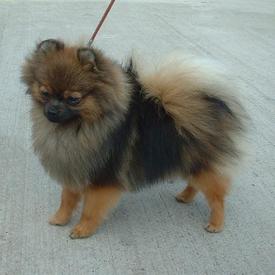
Hailing from Pomerania, a region along the coast of the Baltic Sea, the Pomeranian is a breed of Spitz ancestry, primarily bred as sheep herders in their native land. This might come as a surprise but the original Pomeranian was significantly larger, something which was selectively reduced in the late 19th century. Returning from a holiday to Florence, Italy, Queen Victoria was accompanied by a Pomeranian which she had fallen in love with whilst abroad, and it was in 1888 that she began breeding and showing these dogs, favouring a more miniature build. Other notable figures that owned the breed were Marie Antoinette and Mozart who valued the Pomeranian as a companion and lap dog. At the end of the century, it was not uncommon to observe the Pomeranian performing in the circus. The breed was officially recognised by the American Kennel Club in 1888.
A toy-sized breed, the Pomeranian boasts the typical appearance of a lap dog. Low to the ground with short legs, a narrow and pronounced muzzle, dark eyes, high-set ears and a heavily feathered tail lying flat against the back, the Pomeranian is a distinctive and aesthetically pleasing breed choice, being often seen in the show ring. Thought to descend from ancient Spitz dogs, the Pomeranian shares its profuse double coat, commonly observed in a variety of colours. Whilst red is the most recognised variation, cases of white, cream, orange, brown, blue, wolf or orange sable, brindle, and black and tan are seen. As with most toy breeds, 'Small-Dog Syndrome' is a prevalent problem, with dogs displaying stubborn, dominant and sometimes aggressive behaviours in order to get their master's attention. To avoid this, firm leadership, consistent training and early socialisation is imperative.
Often described as proud, the breed should never be unduly shy or aggressive. Instead, a Pomeranian should be responsive and easy to train, displaying a warm and friendly attitude towards its family and others. Whilst the Pomeranian can be highly affectionate, it is very independent-minded and is content to be left to its own devices. However, no dog should be left for long periods of time without human companionship, as this can lead to destructive behaviours, induced by misery and boredom, around the home. On average, a healthy Pomeranian will weigh 1-3 kg, with a life expectancy of 15 years. There are many documented cases of Pomeranians living into their 20s.
The Pomeranian does not regularly suffer ill-health, although several ailments have been identified in the breed, which should be kept in mind. These range from mild cases of hair loss and allergies, to more serious incidences of tooth decay, skin disease, cardiac weakness, optical disorders and Legg-Calve-Perthes - a rare, degenerative leg disease.
Do you own a Pomeranian? Let others know what they're like!
Related products
ROYAL CANIN® Pomeranian Adult Wet Dog Food
from £10.63
ROYAL CANIN® Pomeranian Adult Dry Dog Food
from £13.49
Busy Buddy Tug-a-Jug
from £21.35
TropiClean Perfect Fur Thick Double Coat Shampoo for Dogs
from £10.99
Busy Buddy Bouncy Bone
from £8.47
Busy Buddy Bristle Bone
from £15.82
KONG Anxiety Reducing Shirt for Dogs
from £17.30
Pawz Natural Rubber Dog Boots
from £9.99